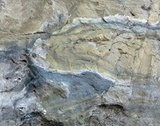Uranium
Uranium is an extremely heavy metal, but instead of sinking into the Earth's core it is concentrated on the surface. Uranium is found almost exclusively in the Earth's continental crust, because its atoms don't fit in the crystal structure of the minerals of the mantle. Geochemists consider uranium one of the incompatible elements, more specifically a member of the large-ion lithophile element or LILE group. Its average abundance, over the whole continental crust, is a bit less than 3 parts per million.

Uranium never occurs as bare metal; rather, it most often occurs in oxides as the minerals uraninite (UO2) or pitchblende (U3O8). In solution, uranium travels in molecular complexes with carbonate, sulfate and chloride as long as the chemical conditions are oxidizing. But under reducing conditions, uranium drops out of solution into mineral form. Carbon behaves the same way, as do several other elements.) This behavior is the key to uranium prospecting. Uranium deposits mainly occur in two geologic settings, a relatively cool one in sedimentary rocks and a hot one in granites.
Sedimentary Uranium Deposits
Because uranium moves in solution under oxidizing conditions and drops out under reducing conditions, it tends to gather where oxygen is absent, such as in black shales and other rocks rich in organic material. If oxidizing fluids move in, they mobilize the uranium and concentrate it along the front of the moving fluid. The famous roll-front uranium deposits of the Colorado Plateau are of this type, dating from the last few hundred million years. The uranium concentrations are not very high, but they are easy to mine and process.
The great uranium deposits of northern Saskatchewan, in Canada, are also of sedimentary origin but with a different scenario of much greater age. There an ancient continent was deeply eroded during the Early Proterozoic Era some 2 billion years ago, then was covered by deep layers of sedimentary rock. The unconformity between the eroded basement rocks and overlying sedimentary basin rocks is where chemical activity and fluid flows concentrated uranium into orebodies reaching 70 percent purity. Geological Survey Canada has an online report on its unconformity-associated uranium deposits with full details of this still-mysterious process.
Granitic Uranium Deposits
As large bodies of granite solidify, the trace amounts of uranium become concentrated in the last bits of fluid left. Especially at shallow levels, these may fracture and invade surrounding rocks with metal-bearing fluids, leaving veins of ore. More episodes of tectonic activity can concentrate these further, and the world's largest uranium deposit is one of these, a hematite breccia complex at Olympic Dam in South Australia.
Good specimens of uranium minerals are found in the final stage of granite solidification—the veins of large crystals and unusual minerals called pegmatites. There may be found cubic crystals of uraninite, black crusts of pitchblende and plates of uranium-phosphate minerals such as torbernite (Cu(UO2)(PO4)2·8–12H2O). Silver, vanadium and arsenic minerals are also common where uranium is found.
Pegmatite uranium is not worth mining today, because the ore deposits are small. But they are where the good mineral specimens are found.
The radioactivity of uranium affects the minerals around it. If you are examining a pegmatite, these signs of uranium include blackened fluorite, blue celestite, smoky quartz, golden beryl and red-stained feldspars. Also, chalcedony that contains uranium is intensely fluorescent with a yellow-green color.
Uranium in Commerce
Uranium is prized for its enormous energy content, which can be harnessed to generate heat in nuclear reactors or unleashed in nuclear explosives. The Nuclear Nonproliferation Treaty and other international agreements govern traffic in uranium to ensure that it is used only for civilian purposes. World trade in uranium amounts to more than 60,000 metric tons, all of it accounted for under international protocols. The largest producers of uranium are Canada, Australia and Kazakhstan.
The price of uranium has fluctuated with the fortunes of the nuclear power industry and the military needs of various countries. After the collapse of the Soviet Union, large stores of enriched uranium have been diluted and sold as nuclear fuel under the Highly Uranium Purchase Agreement, which kept prices low through the 1990s.
As of about 2005, however, prices have been climbing and prospectors are out in the field again for the first time in a generation. And with renewed attention on nuclear power as a zero-carbon energy source in the context of global warming, it is time to become familiar again with uranium.



ساحة النقاش